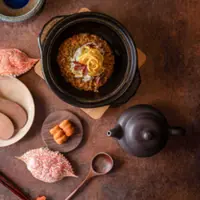The shima aji represents Low's careful veering towards Japanese ingredients, as and when required. — ABIRAMI DURAI/The Star
Evolution is the way in which we embrace change – both in ourselves and in the world at large. It is a sign of growth and discovery and often a catalyst for bold, brand new ideas and inceptions.
But implementing change isn’t easy – especially if you are pivoting even marginally from something you have become known for. This is exactly the sort of dilemma that Aidan Low, the celebrated chef-owner of Akar Dining, faced before he finally made the decision to renovate the eatery and recalibrate the restaurant’s culinary DNA – a makeover that was unveiled a month ago.
Low first opened Akar in 2020 in Kuala Lumpur’s Taman Tun Dr Ismail, at the start of the Covid-19 pandemic. Over the years, his eatery has become a force to be reckoned with in the modern Malaysian cuisine realm and Low has received critical acclaim for his singular mission of championing everything local.
But behind the scenes, Low himself felt like he was very constricted in what he was doing, especially since he spent years working in Japan, an experience that became the backbone of his culinary ethos and identity. When he narrowed his focus to working with nearly 100% Malaysian produce, he gradually felt a sense of dissonance from his culinary roots.
“I think it was something that was simmering inside. Because every time I tried to do a single dish, I would think ‘This Japanese ingredient might go well with this dish’. But we were also trying to focus on local ingredients, so then I would think ‘Maybe not’. This happened quite a few times and then I thought maybe this is not something I should take away. So I decided to embrace it instead.
“I think this Malaysian-Japanese interplay is a more natural fit for me. I feel like the food – in terms of flavour – is not so forced, it’s a bit more natural. And people can understand better what we are trying to do. We still consider ourselves modern Malaysian, just that we also include certain Japanese ingredients if they fit the frame,” he says.
To go with the menu evolution, Low also decided to give the eatery a facelift and a more narrative-driven element to its aesthetic. Instead of a regular dining space, the eatery now has compartments – a heavy steel sliding door leads to a waiting area with eastern Malaysian elements to it, accentuated by hand-cut terracotta tiles. This then segues to a walkway that leads to the restaurant itself where a show kitchen displays the various local ingredients that are in use in the eatery, from local cocoa to turnips.
The dining area is awash in mood lighting and has a more cosmopolitan appeal to it. Perhaps most impressive of all is the fact that Low has managed to create a successful reincarnation of the restaurant without actually having to move to an entirely new locale.
The Mekar tasting menu, priced at RM480++ (additional RM300++ for wine pairing) offers a rich panoply of dishes that are representative of Low’s new ethos. While local ingredients are still a key highlight of the menu – from Cherry Valley duck to Johor cattle – there are also notable additions from the land of the rising sun in the form of Hiroshima oysters, Japanese koshihikari rice and shima aji (Japanese striped horse mackerel).
Some of the highlights from the menu include the Breadfruit, which is one-third of the snacks that prologue the meal. This features a squid ink bun filled with salted egg yolk kaya and topped with duck floss. The kaya is an heirloom recipe from one of Low’s staff and is the true star of this ensemble cast. It is rich and unctuous and features salty notes interspersed with the emblematic sweetness of kaya. This is then juxtaposed against the lightly meaty overtures of the duck floss in what proves to be a meal that is both nostalgic as well as unquestioningly good.
Other high notes from Mekar include the Oyster & Chayote which is essentially Hiroshima oysters that have been turned into ice-cream and rounded out by laco-fermented sambal and sea grapes (latok) sourced from Sabah.
This is an entirely unique and original creation that is also a pure triumph. The oyster ice-cream – paradoxical as it might sound – is sublime. It combines all the velvety sumptuousness of oysters in a silken smooth ice-cream with sweet undertones and a briny overcoat. This is offset by the sambal, which is a covert operator that colludes to shine the spotlight on the ice-cream.
The sea grapes meanwhile add a pronounced aquatic overlay to the meal, offering pearly sea-faring nuances to the meal. It’s bold, new and perhaps most important of all, very memorable.The Shima Aji & Kale showcases another Japanese seasonal ingredient and is paired with a locally-grown Japanese turnip. The fish is very good and has a slightly smoky underbelly that melds well with the garlic and spring onion aioli. The dish makes good on Low’s promise of introducing Japanese ingredients only when he has a need for them. In this particular offering, the shima aji makes all the difference – for very good reasons.
Up next, there is a return to home soil with the Aged Duck. In Low’s interpretation, there is a bare-bones, simple approach to the dish, which allows the avian creature to shine. Here, the duck has been aged for up to 14 days and then charcoal grilled. This is then elevated by a cekur (sand ginger) rice cake in what seems to be a riff on Peking duck, that is then buoyed by a mulberry jelly. In any case, the duck is good – flavoursome but not too gamey or meaty, with a succulence running through its very core.
The rice cake offers a counterpoint to the meat that is interesting yet not in the least bit overpowering while the mulberry jelly sluices through the richness of the meat.
Perhaps one of the biggest success stories to emerge from the menu is the Crab Claypot, with mud crabs, koshikari rice, engkabang (Borneo tree butter) and noodles made entirely out of egg yolks. This is then paired with a peppery crab broth.
This is a meal to remember. The rice, crab and broth function as a very triumphant triumvirate that work together to seduce the senses into a state of complete and total bliss. And it is a testament to Low’s skill that the ingredients deliver on both premise and promise, sealing the deal with a wonderful explosion of flavours and textures.
Plenty of thought has also been poured into the desserts and you’ll quickly realise this when you tuck into the Fig Leaf, which features an ikan bilis almond crumble, guava jelly and assam boi sugar. It all sounds so dichotomous and ominous (I mean, ikan bilis crumble?) and yet... the reality couldn’t be more different.
The ikan bilis crumble is oddly, the best thing here – crunchy and addictively good alongside the guava and assam boi. Chalk this up to a strange but true tale of something that tastes so much better than it sounds.
Modern Malaysian food has come a long way since it was first introduced nearly a decade ago. With proponents like Low in the mix, there is now a way forward for the cuisine that utilises all its richness while leveraging on the undisputed strengths of another Asian cuisine. Because there are times, when leaning on something else for support helps elevate and catapult. And with the new Akar, Low has clearly discovered his trump card.
Akar Dining
109, Jalan Aminuddin Baki
Taman Tun Dr Ismail
60000 Kuala Lumpur
Tel: 018-277 0597
Open Tuesday to Thursday: 6pm to midnight; Friday to Saturday: Noon to 3pm; 6pm to midnight










